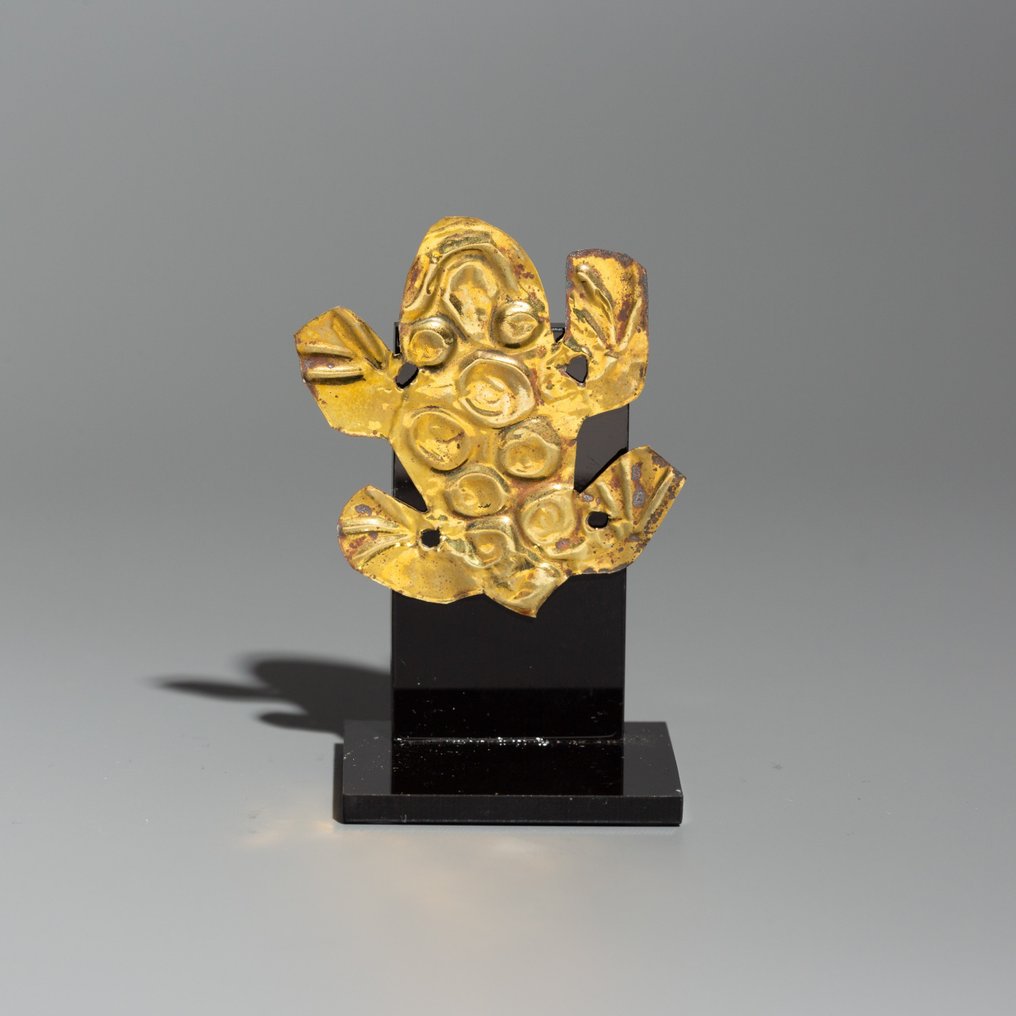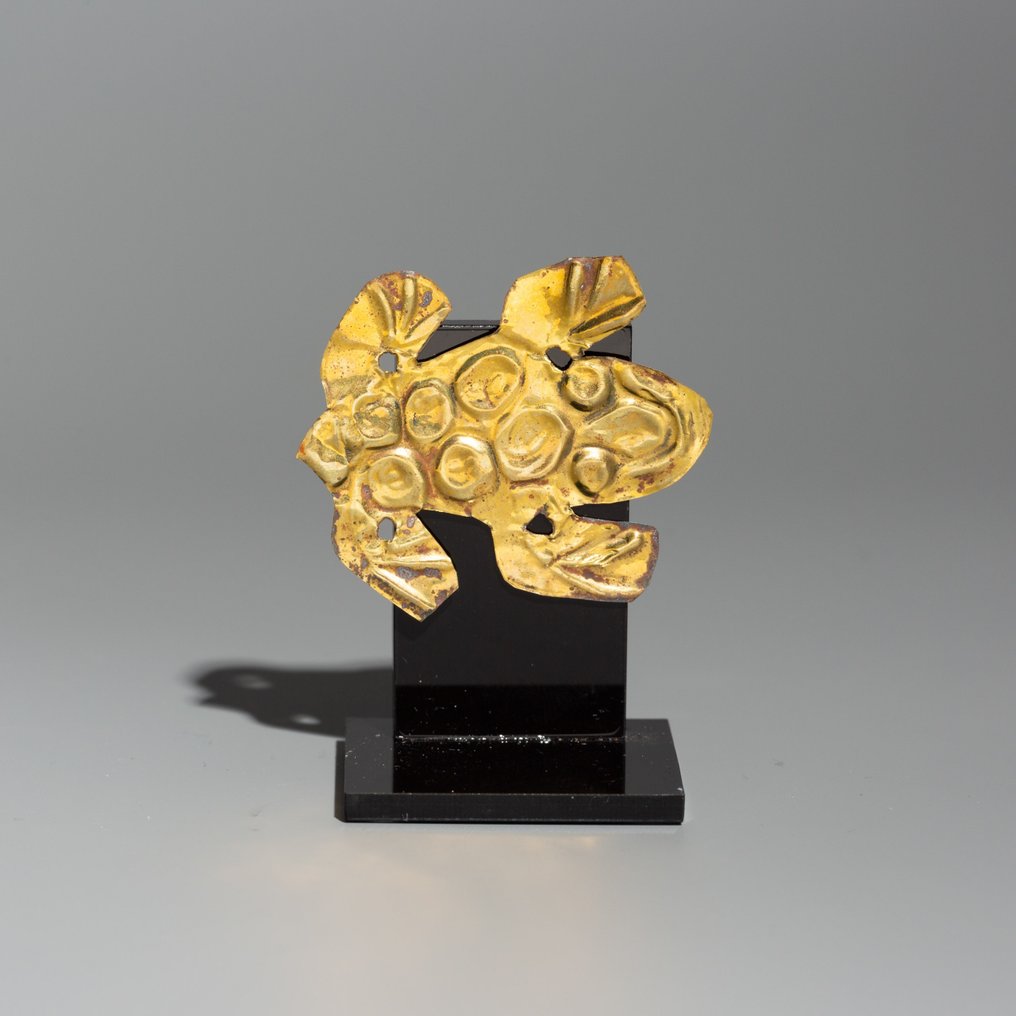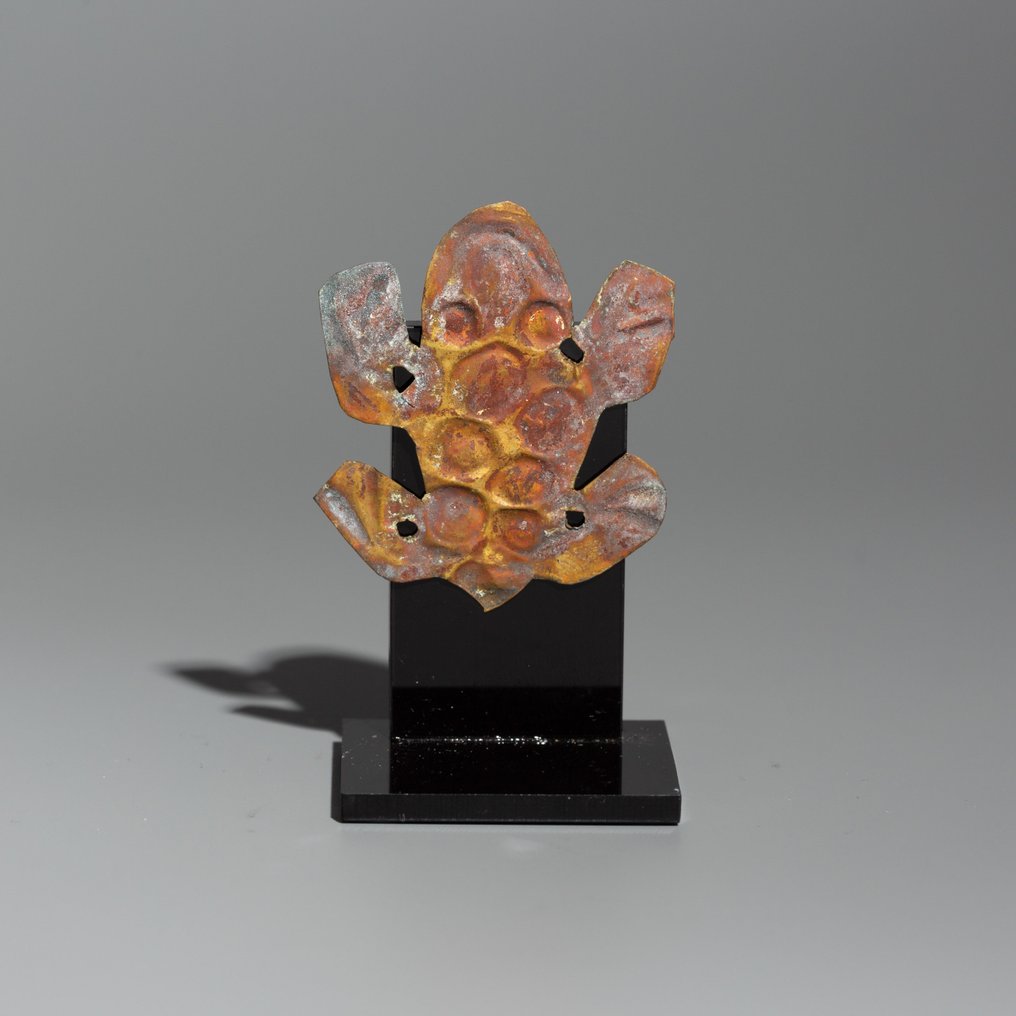Great object. Really beautiful. Quick delivery. Excellent.
Vizualizați traducereaParacas, Perú Aur Aplic în formă de broască pentru tunică. 300-200 î.Hr. 4,3 cm. Licență de import spaniolă.
Nr. 88172129



Applique in the shape of a frog for a tunic.
Paracas, Perú, 300-200 BC.
Gold.
4.3 cm height.
PROVENANCE: Private collection of Ian Arundel, Old Curiosity Shop, Melrose Ave., Los Angeles, United States of America. Acquired around the 1950-60s.
CONDITION: Good condition. Intact.
DESCRIPTION:
The Parakas people inhabited valleys such as Ica and Pisco in what is now the southern coast of Peru. This desert zone faces a seacoast that is rich in natural resources.
The Parakas were an agricultural people, growing maize, squash, cotton, beans and yuca. However, they obtained most of their food from the sea by fishing, hunting marine mammals, and gathering shellfish, seaweed and other products. While they were a society of farmers and fishers, they are known among other things for the expertise of their medicine men, who successfully performed complicated trepanations (making a hole in the skull).
The Parakas craftspeople were most skilled in textile, goldcraft, fire engraved gourds and featherwork.
The cult of the dead appears to have been very important to the Parakas people. The bodies that have been found were placed fully clothed in a squatting position inside woven baskets that were then wrapped with alternate layers of plain and embroidered cloth, with some funeral bundles having up to 20 such layers. Between the layers of cloth they deposited offerings such as musical instruments, feather fans, combs, miniature pieces of cloth, and other items. Many of these pieces were covered with images of fantastic beings. Individuals with feline, serpent or marine animal features, and human figures spitting out mythological animals and bearing a variety of weapons probably represented deities that occupied a central place in the rites and worship of the dead in Parakas culture. A notable figure in Parakas iconography is “the Sacrificer”, who was usually depicted holding a severed head in one hand and an axe in the other.
Initially, the Parakas culture was heavily influenced by the Chavín culture, although over time it acquired its own distinctive features, notable among which is the rich polychromy of its artistic work. This polychromatic legacy left its mark in southern Peru and reached its highest expression in the Nazcas, who were the direct heirs of the Parakas tradition.
Notes:
- The piece includes authenticity certificate.
- The piece includes Spanish Export License (Passport for European Union) - If the piece is destined outside the European Union a substitution of the export permit should be requested, can take between 1-2 weeks maximum.
- The seller guarantees that he acquired this piece according to all national and international laws related to the ownership of cultural property. Provenance statement seen by Catawiki.
Povestea Vânzătorului
Applique in the shape of a frog for a tunic.
Paracas, Perú, 300-200 BC.
Gold.
4.3 cm height.
PROVENANCE: Private collection of Ian Arundel, Old Curiosity Shop, Melrose Ave., Los Angeles, United States of America. Acquired around the 1950-60s.
CONDITION: Good condition. Intact.
DESCRIPTION:
The Parakas people inhabited valleys such as Ica and Pisco in what is now the southern coast of Peru. This desert zone faces a seacoast that is rich in natural resources.
The Parakas were an agricultural people, growing maize, squash, cotton, beans and yuca. However, they obtained most of their food from the sea by fishing, hunting marine mammals, and gathering shellfish, seaweed and other products. While they were a society of farmers and fishers, they are known among other things for the expertise of their medicine men, who successfully performed complicated trepanations (making a hole in the skull).
The Parakas craftspeople were most skilled in textile, goldcraft, fire engraved gourds and featherwork.
The cult of the dead appears to have been very important to the Parakas people. The bodies that have been found were placed fully clothed in a squatting position inside woven baskets that were then wrapped with alternate layers of plain and embroidered cloth, with some funeral bundles having up to 20 such layers. Between the layers of cloth they deposited offerings such as musical instruments, feather fans, combs, miniature pieces of cloth, and other items. Many of these pieces were covered with images of fantastic beings. Individuals with feline, serpent or marine animal features, and human figures spitting out mythological animals and bearing a variety of weapons probably represented deities that occupied a central place in the rites and worship of the dead in Parakas culture. A notable figure in Parakas iconography is “the Sacrificer”, who was usually depicted holding a severed head in one hand and an axe in the other.
Initially, the Parakas culture was heavily influenced by the Chavín culture, although over time it acquired its own distinctive features, notable among which is the rich polychromy of its artistic work. This polychromatic legacy left its mark in southern Peru and reached its highest expression in the Nazcas, who were the direct heirs of the Parakas tradition.
Notes:
- The piece includes authenticity certificate.
- The piece includes Spanish Export License (Passport for European Union) - If the piece is destined outside the European Union a substitution of the export permit should be requested, can take between 1-2 weeks maximum.
- The seller guarantees that he acquired this piece according to all national and international laws related to the ownership of cultural property. Provenance statement seen by Catawiki.
Povestea Vânzătorului
- 823
- 11
- 1
Superbe objet, Service d'Arqueologia Ancient Art excellent et rapide. Jaume Bagot toujours parfait .
Vizualizați traducereaTodo perfecto gracias
Vizualizați traducereaNice item all ok A+++
Vizualizați traducereaThank you for this Oinochoe, one question: did you as promised read my post!
Vizualizați traducereaExcellent translation, and very prompt delivery. Imperfect packaging. A significant crack of the board that had not been described in the original post of the item.
Vizualizați traducereaAlways a great pleasure!
Vizualizați traducereaFine quality, good service. Thanks.
Vizualizați traducereaMuy amables, muy bien todo. Gracias
Vizualizați traducereaAlles bestens
Vizualizați traducereaexactly as described and shipped safely and punctually.
Vizualizați traducereaschnelle Lieferung sehr sichere Verpackung alles bestens
Vizualizați traducereatres bel objet je le recherchai depuis longtemps envoi rapide et protégé je pense qu'il y aura d'autres achats avec ce vendeur merci +++++++
Vizualizați traducereaEinfach nur toll
Vizualizați traducereaTodo perfecto
Vizualizați traducereaottimo
Vizualizați traducereaperfetto
Vizualizați traducereatop oggetto bellissimo grazie 💯💯💯💯💯💯 :-)
Vizualizați traducereaI bought this beautiful artifact together with artifact from Mr. Bagot but although it is clearly stated on his shipping page that when purchasing multiple artifacts i paid the double package costs
Vizualizați traducereaI bought this beautiful artifact together with artifact from Mr. Bagot but although it is clearly stated on his shipping page that when purchasing multiple artifacts i paid the double package costs
Vizualizați traducereaBel objet, bien emballé. Parfait.
Vizualizați traducereawonderful faiece and very fast shipping.thanks a lot
Vizualizați traducereaJ Bagot es un profesional excelente. Sus artículos son de gran calidad, se incluye la documentación necesaria y el embalaje se realiza con esmero. Le recomiendo encarecidamente.
Vizualizați traducereao envio foi bastante rápido, obrigado.
Vizualizați traducereaSono molto soddisfatto grazie.
Vizualizați traducerea- 823
- 11
- 1
Great object. Really beautiful. Quick delivery. Excellent.
Vizualizați traducerea








